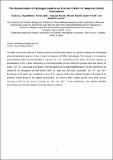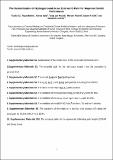Files in this item
The destabilization of hydrogen bonds in an external E-field for improved switch performance
Item metadata
| dc.contributor.author | Xu, Tianlv | |
| dc.contributor.author | Momen, Roya | |
| dc.contributor.author | Azizi, Alireza | |
| dc.contributor.author | van Mourik, Tanja | |
| dc.contributor.author | Früchtl, Herbert | |
| dc.contributor.author | Kirk, Steven R. | |
| dc.contributor.author | Jenkins, Samantha | |
| dc.date.accessioned | 2020-04-12T23:32:12Z | |
| dc.date.available | 2020-04-12T23:32:12Z | |
| dc.date.issued | 2019-04-13 | |
| dc.identifier | 258643229 | |
| dc.identifier | 35da87e1-ca6b-4403-b0ef-f9357240a8a0 | |
| dc.identifier | 85064481609 | |
| dc.identifier | 000471801100002 | |
| dc.identifier.citation | Xu , T , Momen , R , Azizi , A , van Mourik , T , Früchtl , H , Kirk , S R & Jenkins , S 2019 , ' The destabilization of hydrogen bonds in an external E-field for improved switch performance ' , Journal of Computational Chemistry , vol. Early View . https://doi.org/10.1002/jcc.25843 | en |
| dc.identifier.issn | 0192-8651 | |
| dc.identifier.other | RIS: urn:03FE8D07DDFCE167B71B9CDF22458565 | |
| dc.identifier.other | ORCID: /0000-0001-7683-3293/work/57088448 | |
| dc.identifier.other | ORCID: /0000-0001-6647-4266/work/60887472 | |
| dc.identifier.uri | https://hdl.handle.net/10023/19787 | |
| dc.description | The National Natural Science Foundation of China is acknowledged, project approval number: 21673071. The One Hundred Talents Foundation of Hunan Province are gratefully acknowledged for the support of S.J. and S.R.K. The Royal Society is thanked by S.J., S.R.K, T.X, T.v.M, and H.F. for support through an International Exchanges grant. We thank EaStCHEM for computational support via the EaStCHEM Research Computing Facility. | en |
| dc.description.abstract | The effect of an electric field on a recently proposed molecular switch based on a quinone analogue was investigated using next‐generation quantum theory of atoms in molecules (QTAIM) methodology. The reversal of a homogenous external electric field was demonstrated to improve the “OFF” functioning of the switch. This was achieved by destabilization of the H atom participating in the tautomerization process along the hydrogen bond that defines the switch. The “ON” functioning of the switch, from the position of the tautomerization barrier, is also improved by the reversal of the homogenous external electric field: this result was previously inaccessible. The “ON” and “OFF” functioning of the switch was visualized in terms of the response of the most preferred directions of motion of the electronic charge density to the applied external field. All measures from QTAIM and the stress tensor provide consistent results for the factors affecting the “ON” and “OFF” switch performance. Our analysis therefore demonstrates use for future design of molecular electronic devices. | |
| dc.format.extent | 2520161 | |
| dc.format.extent | 3670897 | |
| dc.language.iso | eng | |
| dc.relation.ispartof | Journal of Computational Chemistry | en |
| dc.subject | QTAIM | en |
| dc.subject | Stress tensor | en |
| dc.subject | Molecular switches | en |
| dc.subject | Hydrogen bond | en |
| dc.subject | Tautomerization process | en |
| dc.subject | QD Chemistry | en |
| dc.subject | T-NDAS | en |
| dc.subject.lcc | QD | en |
| dc.title | The destabilization of hydrogen bonds in an external E-field for improved switch performance | en |
| dc.type | Journal article | en |
| dc.contributor.institution | University of St Andrews. School of Chemistry | en |
| dc.contributor.institution | University of St Andrews. Centre for Research into Equality, Diversity & Inclusion | en |
| dc.contributor.institution | University of St Andrews. EaSTCHEM | en |
| dc.identifier.doi | 10.1002/jcc.25843 | |
| dc.description.status | Peer reviewed | en |
| dc.date.embargoedUntil | 2020-04-13 |
This item appears in the following Collection(s)
Items in the St Andrews Research Repository are protected by copyright, with all rights reserved, unless otherwise indicated.


